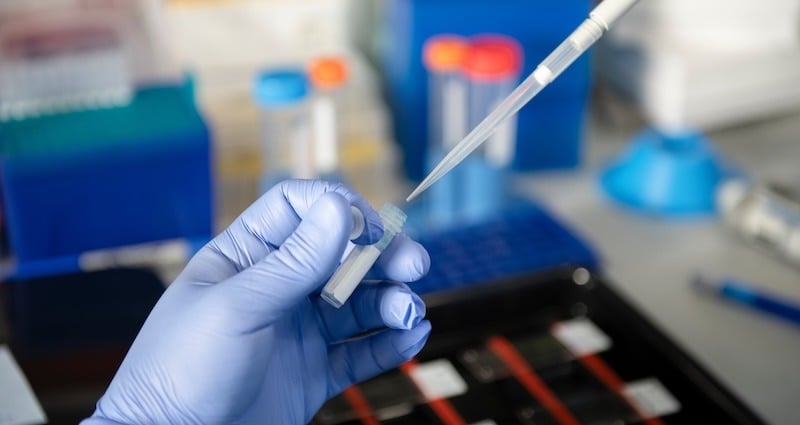
Pharmacogenomics testing stands as the intersection where pharmaceuticals meet genetics. This scientific discipline, blending the principles of pharmacology and genomics, opens up new avenues for understanding how an individual's genetic makeup influences their response to various drugs. With just 50% of the 4 billion prescriptions issued in the United States each year deemed “effective,” this field of testing is proving to be a cornerstone of personalized medicine.
In this blog, we’ll cover everything you need to know about pharmacogenomics, discussing the various types of testing available, its purpose and use cases, and how it might be useful in healthcare. Come along
What is pharmacogenomics testing?
Pharmacogenomics is predicated on the idea that no two individuals are exactly alike when it comes to processing and responding to medications. This variability can be attributed to differences in our genes, which can influence a range of drug-related interactions, from absorption and distribution to metabolism and excretion. The ultimate goal of pharmacogenomics is to harness this genetic information to predict which medications and dosages will be most effective and safe for each patient, marking a departure from the one-size-fits-all approach traditionally used in prescription medicine.
Pharmacogenomics testing vs genetic testing: what’s the difference?
Pharmacogenomics and genetic testing are both integral to the landscape of personalized medicine, while serving distinctly different aspects of this field of patient care. Pharmacogenomics focuses on how an individual's genetic makeup affects their response to medications, aiming to tailor drug therapies to one’s genetic profile for optimal efficacy and safety. It's the convergence of pharmaceutical science and genetics to ensure medications are precisely matched to a patient's genetic predispositions, reducing adverse reactions and improving outcomes.
On the other hand, genetic testing encompasses a broader range of applications, including the identification of genetic disorders, the assessment of disease risk, and the exploration of ancestry. While pharmacogenomics is a subset of genetic testing with a specific focus on drug response, genetic testing as a whole delves into various aspects of an individual's genetics to inform about health, heritage, and more. Together, they represent the pillars of personalized medicine, each playing a unique role in customizing healthcare to the individual.
The Impact of Pharmacogenomics on Drug Prescription
The implications of pharmacogenomics for drug prescription are profound. By identifying genetic markers that predict drug response, healthcare providers can preemptively adjust medication types and dosages to better suit each patient's genetic makeup. This approach not only improves patient outcomes but also significantly diminishes the risk of adverse drug reactions, a leading cause of hospitalization and mortality worldwide.
In mental health treatment, for example, pharmacogenomics testing can help determine the most appropriate medication for conditions like depression, anxiety, or bipolar disorder, reducing the trial-and-error process often associated with psychiatric medication prescription. Similarly, in the treatment of chronic conditions like heart disease or diabetes, pharmacogenomics can guide the selection of drugs to maximize therapeutic benefits while minimizing side effects.
What Is the Purpose of Pharmacogenomics Testing
Exploring the practical applications of pharmacogenomics testing reveals its pivotal role in modern medicine. Here's a closer look at the key areas where this innovative testing makes a significant impact:
- Personalizing Drug Therapy: Tailoring medication types and dosages to the individual's genetic makeup to maximize efficacy and minimize adverse effects. This customization ensures that patients receive the most appropriate medication for their unique genetic makeup.
- Improving Drug Safety: By understanding how different genetic variations affect drug metabolism, pharmacogenomics testing can significantly reduce the risk of adverse drug reactions, a leading cause of hospitalizations and patient morbidity.
- Enhancing Drug Development: Pharmacogenomics can identify which drug compounds are likely to be most effective for specific genetic profiles, streamlining the drug development process and leading to more targeted and successful therapies.
- Guiding Dosage Amounts: Certain genetic markers can influence how quickly or slowly a person metabolizes a drug, affecting the drug's concentration in the body. Pharmacogenomics testing helps determine the optimal dosage for each patient, avoiding underdosing or overdosing.
- Predicting Drug Efficacy: Before starting a treatment regimen, pharmacogenomics can predict whether a patient is likely to respond to a given medication, allowing healthcare providers to make informed decisions and potentially avoiding trial and error with different drugs.
- Cost Effectiveness: Tailoring medicine prescriptions saves time spent on trying different drugs, as well as health insurance and tax payer’s money.
- Advancing Precision Medicine: As a cornerstone of precision medicine, pharmacogenomics testing paves the way for more personalized, predictive, and preventive healthcare, shifting the paradigm from a one-size-fits-all approach to more individualized care.
Swab Test vs Spit Test for Pharmacogenomics
The choice between a swab and a spit test for pharmacogenomics largely depends on the specific requirements of the test being conducted, the setting, and the subject's ability to provide a sample. Swab tests offer a controlled, quick, and less variable method of collection, making them ideal for clinical environments and situations requiring high precision. On the other hand, spit tests offer a convenient and user-friendly option, suitable for at-home testing kits and scenarios where sample collection's ease and comfort are prioritized.
For pharmacogenomics, Puritan supports swab testing with our products. The swab test, particularly the buccal swab, involves gently rubbing a specialized swab against the inside of the cheek to collect cells. This method is highly favored for its non-invasive nature, ease of use, and the reliable quality of DNA it can collect. Swab tests are particularly useful in clinical settings or when conducting tests on a broad scale due to their straightforward, quick, and relatively error-proof collection process. Moreover, swab tests minimize the risk of sample dilution or contamination, providing a robust source of DNA for pharmacogenomic analysis. They are especially suitable for individuals who may have difficulty producing sufficient saliva for a spit test or for populations such as infants and the elderly.
How to Collect a Pharmacogenomics Test Sample
Buccal cell sampling is a straightforward yet critical procedure widely used in DNA testing. This non-invasive method involves collecting cells from the inner cheek, offering a convenient alternative to blood draws for obtaining DNA samples. Here, we provide an in-depth look at how to properly collect a buccal cell sample, featuring products from Puritan, renowned for their reliability and superior sample collection efficiency.
Preparation: The First Step Toward Pharmacogenomics Testing Accuracy
Step 1: Prepare
Before you begin, it's crucial to don appropriate personal protective equipment (PPE), including gloves, to ensure both the collector's and subject's safety. Removing the swab from its packaging while avoiding any contact with the swab tip is paramount to preventing contamination.
Step-by-Step Pharmacogenomics Testing Collection Process
Step 2: Initial Swab Insertion
Gently insert the swab into the subject's mouth. Firmly rub the swab up and down against the inside of one cheek approximately 10 times. This motion is crucial for collecting a sufficient number of cells for analysis.
Step 3: Repeat on the Opposite Cheek
Perform the same rubbing action on the other side of the mouth to ensure a thorough collection. Holding the swab by its handle is vital; avoid touching the swab above any breakpoint indicator mark. Applying gentle external pressure to the cheek can enhance contact with the swab tip, optimizing cell collection.
Step 4: Proper Swab Removal
Carefully remove the swab from the mouth, ensuring it does not come into contact with teeth, the tongue, or any other surfaces that could contaminate the sample.
Step 5: Post-Collection Handling
Allow the swab to air dry before packaging it for transport. This step is crucial for transport to preserve the integrity of the collected cells. However, if using a liquid processing system or an aerated transport tube device, the sample may not require air drying. Proceed with processing the sample according to standard laboratory protocols.
By following these detailed steps and choosing high-quality swabs like those offered by Puritan, healthcare professionals and researchers can ensure effective and efficient buccal cell sample collection. This guide serves as a resource for obtaining samples that are crucial for accurate DNA analysis, ultimately supporting advancements in personalized medicine, genetic research, and beyond.
Want a handy how-to guide to follow with visual guidance? Download our guide on “How To Collect a Buccal Cell Sample” guide.
How to Choose the Right Swab Type for Pharmacogenomic Testing
A pivotal aspect of pharmacogenomics testing involves the collection of DNA samples, which is where the innovation of non-invasive swabbing techniques comes into play. Buccal swabs, in particular, have become the method of choice for many due to their simplicity, efficiency, and patient comfort. These swabs gently collect cells from the inside of a patient's cheek, providing the DNA needed for genetic analysis without the need for needles or blood draws.
Puritan’s flocked swabs are especially suited for this purpose. Designed with a unique microstructure, these swabs ensure optimal sample collection and release, facilitating the accurate analysis critical for pharmacogenomics testing. The flocked DNA swabs most often chosen for pharmacogenomics include:
- HydraFlock® Flocked Swab, Standard Tip
- HydraFlock® Flocked Swab, Elongated Tip
- DNA Free, Ultra Flocked Swab with Transport Tube
Why Choose Flocked Material for Pharmacogenomic Swab Tests
In the evolving field of pharmacogenomics, the quality of the DNA sample collected is paramount. This is where Puritan’s flocked swabs stand out as the optimal choice for pharmacogenomic testing.
- Optimized Sample Collection and Release: Puritan's commitment to excellence is embodied in its HydraFlock® and PurFlock Ultra® flocked swabs, designed with user feedback and proprietary manufacturing processes. These swabs feature an intricate fiber technology, patented for its remarkable collection and elution capacities—among the highest available in the market. This makes them particularly suitable for sensitive pharmacogenomic applications where maximizing the quantity and quality of the collected genetic material is crucial.
- Material Integrity for Accurate Testing: The tips of these swabs are made from flocked polyester fibers, meticulously engineered to absorb organisms efficiently at the collection site and maintain viability during transport and elution. The unique structure of the fibers, with HydraFlock® having blossomed ends to increase the surface area, ensures higher absorption capacity and complete elution of the sample. This characteristic is vital for pharmacogenomic testing, where every genetic marker counts towards tailoring personalized medication regimens.
- Purity and Compatibility: PurFlock Ultra® is celebrated for its ultimate purity and efficient cell release characteristics, making it an ideal choice for PCR, molecular assays, rapid tests, and forensic applications. Unlike other materials that may have coatings or treatments that interfere with sample integrity, Puritan’s flocked swabs ensure that what is collected is a pure representation of the patient's DNA, free from external contaminants.
- Designed for Convenience and Efficiency: Moreover, Puritan's attention to the practical aspects of sample collection is evident in the design of their swabs. With handles featuring varying, pre-molded breakpoints and the option for custom breakpoints and print, healthcare professionals can easily use and transport the swabs, simplifying the collection process. The absence of adhesive residue or fiber treatments further underscores the commitment to sample integrity and ease of use.
The Puritan Difference in Supporting Pharmacogenomics Testing
Choosing Puritan’s HydraFlock® and PurFlock Ultra® flocked swabs for pharmacogenomic swab tests ensures that healthcare providers and researchers are using the highest-performing collection and elution tools available. Manufactured in the USA, these swabs represent the pinnacle of swab technology, setting the standard for accuracy, reliability, and patient care in the burgeoning field of pharmacogenomics.
By integrating advanced materials technology with thoughtful design, Puritan provides the tools necessary for the precise and effective collection of genetic material. This commitment to quality and innovation makes Puritan’s flocked swabs the unequivocal choice for professionals aiming to harness the power of pharmacogenomics in patient care.
Want to learn more about our flocked swab products? Get in touch with our team. They’d be happy to support you and answer any questions you may have.




